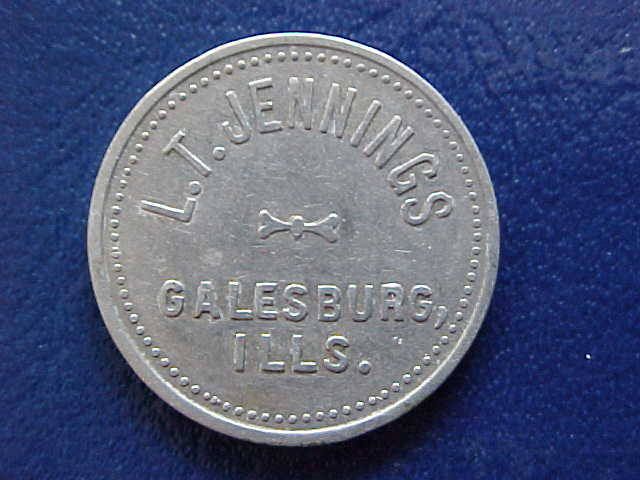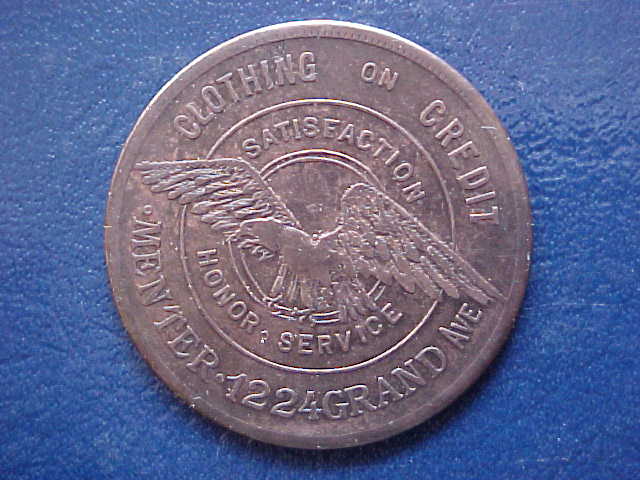

BACKTRACKING
Token Article
by Terry Hogan
I need to admit it right up front. It's the right thing to do. This is nothing more than a token article. Judging from the e-mails to the editor, I have only a few readers who are not "relations". So, when I get a letter from a non-relative with a suggested topic for an article, and the letter even includes a couple of relevant examples, I take the suggestion. Otherwise, I might lose a third of my non-relation readers. So here it is, my token article.
Once upon a time, our money was worth something. Once upon a time, there were vending machines that took pennies and gave you something in return. Remember when pennies had some use, beyond paying sales tax? Today, if you want a gum ball from a vending machine, you put in a quarter.
Well, if you go back far enough, you can find examples of how valuable our money used to be. Our money used to be so valuable, that retailers could produce and give metal tokens that were redeemable for discounts at their stores. This wasn't only done in the big cities like Chicago and New York, but even in smaller cities, with fewer customers.
When I opened the envelope, there was a half-page letter and two tokens. The tokens were from a desk drawer of an elderly Galesburg resident who had died. The tokens apparently had inhabited the drawer for decades.
The first, and presumably older, of the two was marked on one side with the name "L.T. JENNINGS" and "GALESBURG, ILLS." The opposite side showed a centered large "5 c" with the text "IN TRADE" below. (I can't make the old cent abbreviation on my computer). The token is about one inch in diameter. There is no date, nor is there any indication as to what L. T. JENNINGS was or what it sold.


The second token is larger, about one and a quarter inches in diameter and appears to be copper. It is also probably newer that the other, as it has a face value of one dollar "on purchase of $10 or more." The other side of the coin has, at its center, an impressive eagle with wings extended. The margin has the phrase "CLOTHING ON CREDIT" above the eagle and "MENTER 1224GRAND Ave" (sic) below the eagle. The words "SATISFACTION", "HONOR" and "SERVICE" are also on the token, between the eagle and the marginal words. It is assumed that this token is also from Galesburg, given its source and the reference to Grand Avenue.
When did tokens die out? Probably the "why" they died out can be found in their definition. Webster defines a token to be "a piece of stamped metal with a face value higher than it's real value, issued as a substitute for currency." Probably the cost to make the tokens became too high. The retailer had to pay twice - the cost of the token and the face value of the token. When did it become too expensive to make a metal token to entice the return of a customer?
Of course, now we have paper coupons that can be scanned. But it's not the same. Are we likely to reminisce over a tattered, faded scrape of paper that promised to give us 25 cents off the next box of widget cleaners? Will we be awed by the detail and beauty of the bar code? I certainly hope not, as it would reflect the status to which our art and culture had dropped.
I did a search on the Internet for "Menter Clothing" and for "L.T. Jennings." I found some reference to Menter stores, but not in Galesburg. Nor do I know that the Mentor stores on the Internet are even connected to the token that was sent to me. I found nothing relevant for the Jennings token.
Such is my token article. Of course, I am hoping that a reader may know about one or both of these tokens and perhaps a little bit about the stores that issued them. If you have information, please e-mail or mail the editor, and indicate whether I can use your name in any follow-up article.